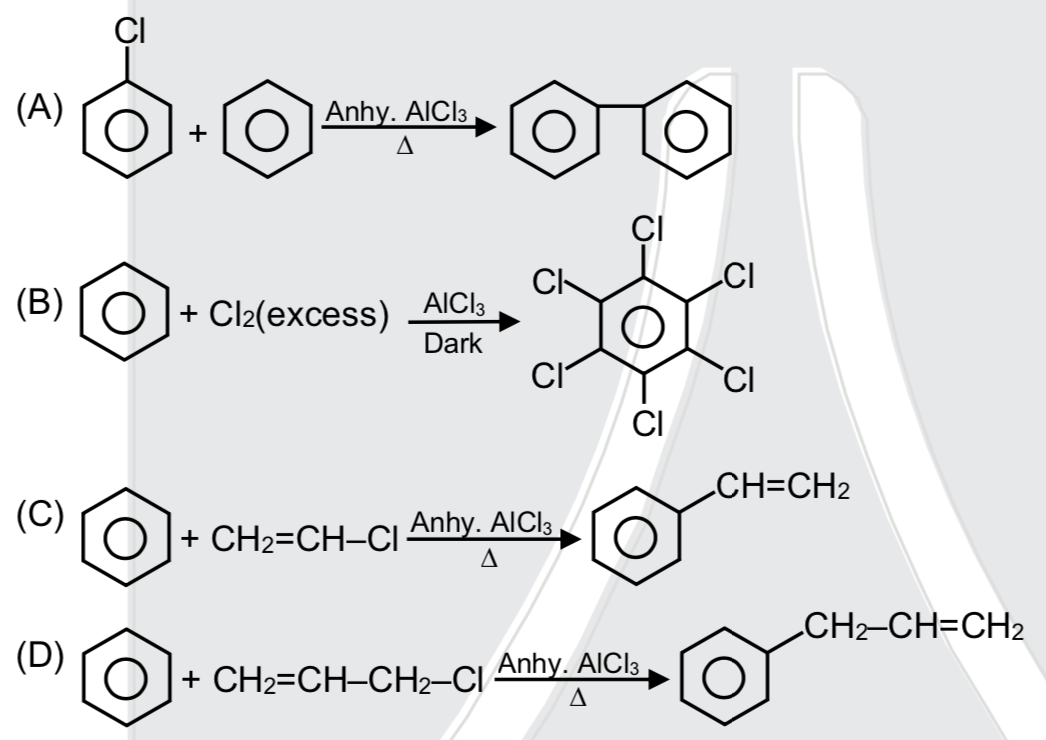Which of the following reactions follows Markovnikov's rule?
C2H4+HBr
C3H6+Cl2
C3H6+HBr
C3H6+Br2
The correct Answer is:C
To determine which of the given reactions follows Markovnikov's rule, we will analyze each reaction step by step.
1. Identify the Reactions:
We have four reactions to analyze:
- Reaction 1: C2H4 + HBr
- Reaction 2: C3H6 + Cl2
- Reaction 3: C3H6 + HBr
- Reaction 4: C3H6 + Br2
2. Analyze Reaction 1: C2H4 + HBr:
- C2H4 is ethylene (CH2=CH2).
- When HBr adds to ethylene, according to Markovnikov's rule, the hydrogen (H) will add to the carbon with more hydrogen atoms (which is both in this case).
- Since both carbons have the same number of hydrogen atoms, this reaction does not favor Markovnikov's rule.
- Conclusion: Reaction 1 does not follow Markovnikov's rule.
3. Analyze Reaction 2: C3H6 + Cl2:
- C3H6 is propene (CH3-CH=CH2).
- The addition of Cl2 will result in a halogenation reaction, forming a vicinal dihalide (both Cl atoms will add to the double bond).
- This reaction does not involve the addition of H and Cl in a manner that follows Markovnikov's rule.
- Conclusion: Reaction 2 does not follow Markovnikov's rule.
4. Analyze Reaction 3: C3H6 + HBr:
- Again, C3H6 is propene (CH3-CH=CH2).
- According to Markovnikov's rule, the hydrogen (H) will add to the carbon with more hydrogen atoms (the CH2 end), and the bromine (Br) will add to the carbon with fewer hydrogen atoms (the CH end).
- The product will be CH3-CHBr-CH3.
- Conclusion: Reaction 3 follows Markovnikov's rule.
5. Analyze Reaction 4: C3H6 + Br2:
- This reaction involves the addition of bromine to propene.
- Similar to Reaction 2, this will lead to the formation of a vicinal dibromide without following Markovnikov's rule.
- Conclusion: Reaction 4 does not follow Markovnikov's rule.
Final Answer:
The reaction that follows Markovnikov's rule is Reaction 3: C3H6 + HBr.
We have four reactions to analyze:
- Reaction 1: C2H4 + HBr
- Reaction 2: C3H6 + Cl2
- Reaction 3: C3H6 + HBr
- Reaction 4: C3H6 + Br2
- C2H4 is ethylene (CH2=CH2).
- When HBr adds to ethylene, according to Markovnikov's rule, the hydrogen (H) will add to the carbon with more hydrogen atoms (which is both in this case).
- Since both carbons have the same number of hydrogen atoms, this reaction does not favor Markovnikov's rule.
- Conclusion: Reaction 1 does not follow Markovnikov's rule.
- C3H6 is propene (CH3-CH=CH2).
- The addition of Cl2 will result in a halogenation reaction, forming a vicinal dihalide (both Cl atoms will add to the double bond).
- This reaction does not involve the addition of H and Cl in a manner that follows Markovnikov's rule.
- Conclusion: Reaction 2 does not follow Markovnikov's rule.
- Again, C3H6 is propene (CH3-CH=CH2).
- According to Markovnikov's rule, the hydrogen (H) will add to the carbon with more hydrogen atoms (the CH2 end), and the bromine (Br) will add to the carbon with fewer hydrogen atoms (the CH end).
- The product will be CH3-CHBr-CH3.
- Conclusion: Reaction 3 follows Markovnikov's rule.
- This reaction involves the addition of bromine to propene.
- Similar to Reaction 2, this will lead to the formation of a vicinal dibromide without following Markovnikov's rule.
- Conclusion: Reaction 4 does not follow Markovnikov's rule.
The reaction that follows Markovnikov's rule is Reaction 3: C3H6 + HBr.
Topper's Solved these Questions
- BOOK - NCERT FINGERTPS ENGLISHCHAPTER - HALOALKANES AND HALOARENESEXERCISE - Physical properties7videos
HALOALKANES AND HALOARENES
- BOOK - NCERT FINGERTPS ENGLISHCHAPTER - HALOALKANES AND HALOARENESEXERCISE - Chemical reactions68videos
HALOALKANES AND HALOARENES
- BOOK - NCERT FINGERTPS ENGLISHCHAPTER - HALOALKANES AND HALOARENESEXERCISE - Nomenclature6videos
HALOALKANES AND HALOARENES
- BOOK - NCERT FINGERTPS ENGLISHCHAPTER - GENERAL PRINCIPLES AND PROCESSES OF ISOLATION OF ELEMENTSEXERCISE - Assertion And Reason15videos
GENERAL PRINCIPLES AND PROCESSES OF ISOLATION OF ELEMENTS
- BOOK - NCERT FINGERTPS ENGLISHCHAPTER - POLYMERS EXERCISE - NCERT Exemplar9videos
POLYMERS
Similar Questions
Which of the following reactions is correct?
View SolutionWhich of the following reactions is correct.
View SolutionWhich of the following reaction is feasible ?
View SolutionWhich of the following reaction is correct :
View SolutionWhich of the following reactions is reversible?
View SolutionWhich of the following reactions are possible ?
 View Solution
View SolutionWhich of the following reactions are possible ?
 View Solution
View SolutionWhich of the following reaction are correct?
View SolutionWhich of the following reactions are feasible ?
View SolutionWhich of the following is redox reaction ?
View Solution

